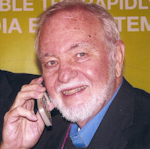Teachers of engineering, technology, science and math are always looking for ways to get across the fundamentals to students in an interesting way. Theory and math is boring without some context or practical application. But what is that? I have come to the conclusion that when teaching any aspect of engineering or science, you can’t beat a robot for an all-round way to teach many different but interrelated concepts.
Back in the early 1980s I helped conceive and my team designed and built one of the first educational robots at Heathkit. It was called HERO, short for Heath Educational Robot. It turned out to be a huge undertaking, especially the mechanical arm we all felt should be a component. The project was a challenge because it involved lots of electronics as well as mechanics. But overall it turned out to be a huge success. It was a fun kit to build and there were many things to be learned from it.
Related Articles
• Moore’s Law Makes Household Robots Possible
• Ham Radio vs Robotics for Luring Kids into Technology
• Robot Development Platforms Take On Mobile Challenges
Think about what is in one of these robots. A power system with battery, charger, regulators and DC-DC converters in some cases. Then there is the propulsion system with its motors, drivers, gears or belts, and servos. Also present were a number of sensors for light, voice, range (ultrasonic radar) and position. And don’t forget the arm with its complicated mechanics and controllers. Then at the heart of it all was an embedded controller, back then a version of the early Motorola 6800 family. The software and programming was machine code and assembler so programming was taught as well. Just think of the examples that can be used in teaching all phases of electronics or science.
The robot kits available today are similar, but mostly without the arm. They offer a teaching platform that can extend from basic circuit fundamentals and mechanical principles through microcontrollers and programming. Wireless is also a part of many robot platforms today as well. Almost a full set of lab activities for several courses. It fulfills an instructor’s need for a good way to demonstrate principles and their application. But best of all, the students love it. It excites them, interests them and gives them something to grasp while learning the theory and concepts behind it all.
You can purchase a number of robot kits from vendors who advertise in Make and Servo magazines. Even toy maker Lego has a line of robots. Yet today, many schools challenge students to design and build their own robots. This approach not only teaches the fundamentals but brings out the creativity in the students as they attempt to apply innovation to their own design.
Robots are great for universities, community colleges and technical schools of all sorts. But they have also found their way into the high schools and middle schools as a way to interest kids in science, math and engineering. One of the organizations that help with such programs is FIRST, For Inspiration and Recognition of Science and Technology. It was established in 1989 as a means to inspire an appreciation of science and technology in young people. FIRST designs innovative programs to build self-confidence, knowledge and life skills while motivating young people to pursue opportunities in science, technology and engineering. FIRST offers college scholarships and hosts a wide range of robotics competitions for different grade levels such as 9-12, 7-12, 4-8 and even K-3.
This week, National Instruments (NI) announced that they were extending their partnership with FIRST through 2019. This partnership centers around the creation of a next-generation embedded robotics control platform code-named Athena. Athena is a super-rugged, reconfigurable controller that when paired with NI’s LabVIEW software makes it possible for FIRST teams to design real systems faster than ever. Students will use Athena in forthcoming seasons of the FIRST Robotics Competition (FRC). Through a donation from NI, FIRST will provide these next-generation robotics systems to participating teams starting in 2015. Students in the FIRST program will actually use the same hardware and software platform that professional engineers now use to create applications in virtually every industry.
If you ever get involved with teaching, full time or part time or as a mentor, think of the robot as a way to improve the education process as there is nothing better than a robot to attract attention, focus interest and illustrate the core fundamentals that all students need to learn. They also make a great hobby in case you are interested.
